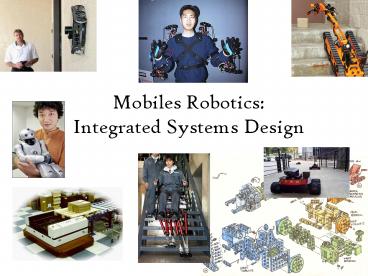Mobiles Robotics: Integrated Systems Design - PowerPoint PPT Presentation
Title:
Mobiles Robotics: Integrated Systems Design
Description:
Title: Robotics: Integrated Systems Design Mechanics, Electronics, Computation, & Integration CS 490, ECE 492, IME 492, ME 492 Author: Jerry Weinberg – PowerPoint PPT presentation
Number of Views:128
Avg rating:3.0/5.0
Title: Mobiles Robotics: Integrated Systems Design
1
Mobiles Robotics Integrated Systems Design
2
Where are the Robots?
- Exploration
3
Where are the Robots?
- Industrial Robots
4
Where are the Robots?
- Medicine
5
Where are the Robots?
- Service Robots
6
Where are the Robots?
- Consumer Robots
7
Where are the Robots?
- Cultural Robots
8
What is a Robot?
- An autonomous system which exists in the physical
world, can sense its environment, and can act on
it to achieve some goals.
9
Spectrum of Self-Control
Teleoperation Human Control
Autonomous (AI) Control
Shared Human Robot Control
10
Living Autonomously
- An autonomous robot acts on its own decisions
- Robots are not directly controlled by humans
- Can take input and advice from humans
- Robots are not teleoperated
- Making them much more difficult and interesting
than Battlebots
11
Autonomous Mobile Robots have to Solve Difficult
Problems
- Where am I?
- Localization Problem
- How do I get there?
- Path Finding Problem
- How do I find the door?
- Object Recognition Problem
- What are you asking me to do?
- Language Understanding Problem
- How can I tell you the answer to your question?
- Speech Generation Problem
12
Existing in the Physical World
- Inaccessible
- near by stimuli, limited attention, imperfect
sensors - Non-deterministic
- Complex set of laws (many unknown)
- Dynamic
- Changes happening as decisions are made
- Continuous
- The worlds is not a set of discrete events
13
Sensing the Environment
- Sensors allow the robot to perceive its
environment to get information that allows it to
make decisions - Humans have 6 senses what are they?
- What sensors does a robot need?
Movie Clip
14
Acting on the Environment
- Robots have effectors that allow it to change the
state of the world - What are human effectors?
- What effectors can robots have?
Movie Clip
Movie Clip
15
Achieving a Goal
- Achieving a goal requires intelligent decision
making - Artificial Intelligence
Movie Clip
16
Robots are complex systemsSo, what makes a
complex systems complex?
17
Interactions Between Sub-systems
- Complex systems consist of multiple sub-systems,
each one has the potential of interacting with
every other one.
18
Complexity comes from Multidisciplinary Systems
- Complex systems can be an integration of
mechanical, electrical, chemical, and
computational sub-systems. - Like vacuum cleaners, washers, cars, hard drives,
space shuttles,
19
and robots.
20
Why study Robotics?
- Well, robots are way coooool!
- Other areas that deal with complex systems share
the same principles involved in designing and
implementing robots
21
Why Study Robotics?
- Real-time Systems
22
Why Study Robotics?
- Multitasking
23
Why Study Robotics?
- Integrated Systems Engineering
- Mechanical Engineering
- Electrical Engineering
- Computer Science
- Chemical Engineering
- Biological
Continental's electronic stability system
analyzes data from many sensors. When the sensors
indicate a driver is losing control, the system
steadies the vehicle by braking one or more
wheels or by slowing down the engine.
24
The Top 10 Reasons for Taking This Course
- 10 I want to play with LEGOs for a grade!
- 9 All the other CS/ME/ECE/IME electives are
lame. - 8 Class is taught by the best teachers in the
School of Engineering. - 7 The Transformers movie ruled, dude!
- 6. I can use the pick-up line
- Want to come see my robot?
25
The Top 10 Reasons for Taking This Course
- 5 So I can invent a robot that looks like me and
Ill never have to go to another class. - 4 I can put on my resume Robot Builder.
- 3 Lots of cool pics, demos, videos.
- 2 I want to take over the world!
- 1 Robots are way cooooool!
- Peace out
26
ROBOTICS
27
And The Categories Are..
Signal Processing
Control
Mechanisms
Navigation
Robots
Sensors
Planning
Integration
Communication
28
Robots for 2.00
- The answer is .
- Robots are built by these.
- And the question is
- What is a cross-functional or
multidisciplinary team?
29
A Multidisciplinary Robotics Course
- Co-taught course
- Dr. Engel, Electrical Computer Engineering
- Dr.Krauss, Mechanical Engineering
- Dr. Karacal, Industrial Manufacturing
Engineering - Dr. Weinberg, Computer Science
30
Course Objectives
- To learn to work in a multidisciplinary team.
- To provide a hands-on experience to practical
robotics. - To learn about integrated system design.
- To study the mechanical mechanisms necessary for
robot movement and actions. - To study the electrical mechanisms of sensor
sampling and signal processing. - To study the computational mechanisms necessary
for sensory perception. - To study the computational mechanisms of
autonomous robotics.
31
Readings
- Textbook
- Robotic Exploration by Fred Martin
- Introduction to AI Robotics by R. Murphy
- Additional reading will be assigned.
- IMPORTANT RIF
- Teaching a multi-disciplinary course is
challenging
32
Designing, Building Programming
- Each class member will participate on a cross
functional team of 3 or 4 students from different
disciplines. - Teams will work on a variety of lab assignments
that include designing building mechanisms,
circuits, and robots - Robot will be built using the XBC
(http//www.charmedlabs.com/ ).
33
Final Project
- Multidisciplinary Teams will design and build a
robot to complete in a Urban Search and Rescue
Challenge - Builds upon lab assignments
34
Grading
- Assignments 25
- Quizzes 25
- Final Exam 20
- Final Project 30
35
Next Class
- Wednesday
- Teamwork
- Form Teams
- Check-out robot kits
- Reading
- First chapters of both text books
- Handouts































